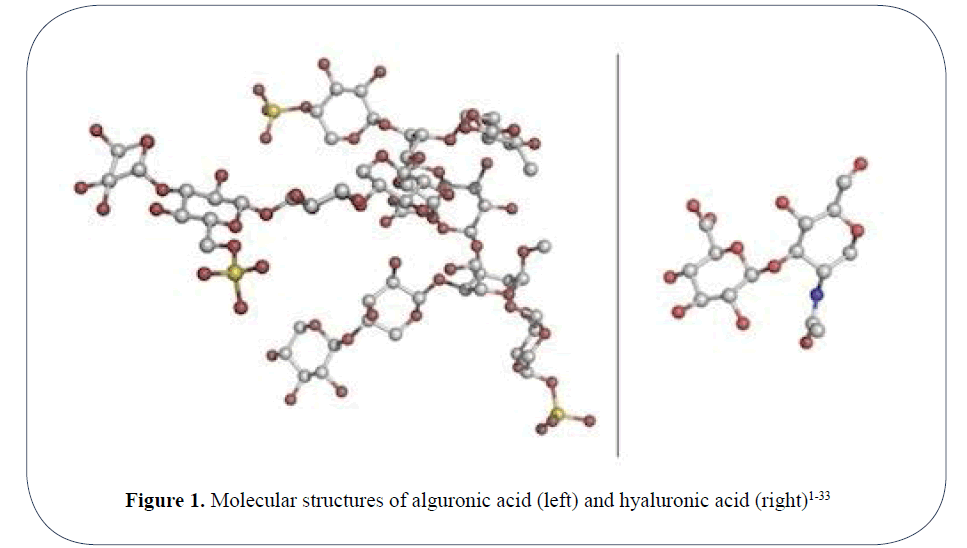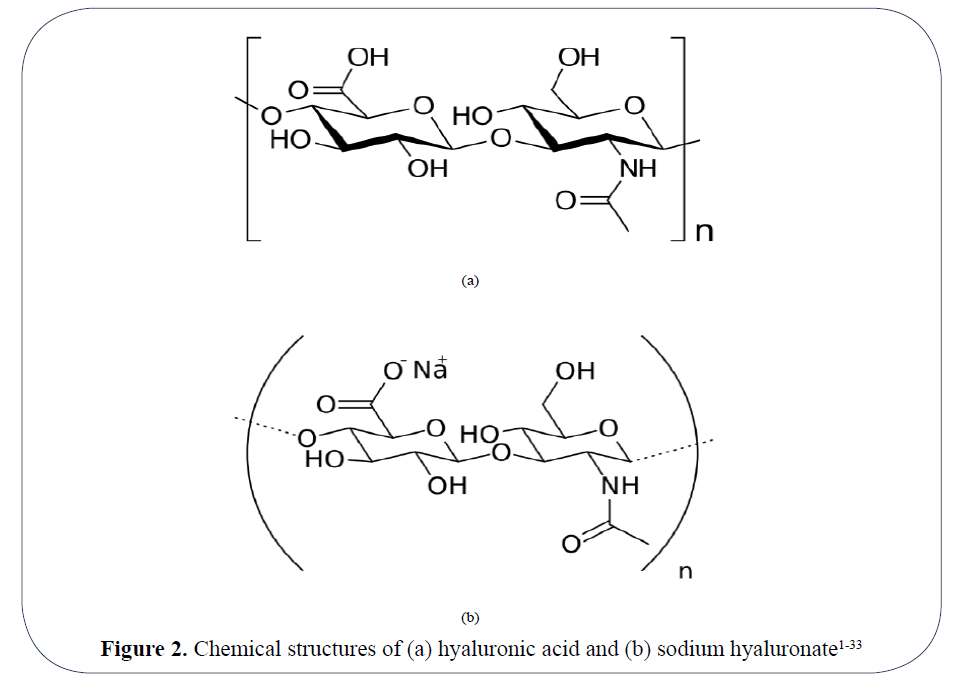Alireza Heidari*
Faculty of Chemistry, California South University, 14731 Comet St. Irvine, CA 92604, USA
*Corresponding Author:
Alireza Heidari
Faculty of Chemistry, California South University
14731 Comet St. Irvine, CA 92604, USA
E-mail: Scholar.Researcher. Scientist@gmail.com
Received Date: 01/07/2017; Accepted Date: 04/07/2017; Published Date: 12/07/2017
Nanomedicine-based combination anti-cancer therapy between nucleic acids and anti-cancer Nano drugs in covalent Nano drugs delivery systems for selective imaging and treatment of human brain tumors using hyaluronic acid, alguronic acid and sodium hyaluronate (Figures 1 and 2) as anti-cancer Nano drugs and nucleic acids delivery under synchrotron radiation has been explored as an alternative approach to the synthesis of electronically and optically active polymers with several advantages1-33. Horseradish Peroxidase (HRP) catalyzes the decomposition of Hydrogen peroxide (H2O2) at the expense of aromatic proton donors. Horseradish Peroxidase (HRP) is a Fe containing porphyrin-type structure. In previous works, we synthesized hyaluronic acid, alguronic acid and sodium hyaluronate, enzymatically1-33. The results of enzymatic polymerization were different from chemical and electrochemical polymerization of hyaluronic acid, alguronic acid and sodium hyaluronate that reported previously1-33. In this editorial, we reported the enzymatic copolymerization of aniline and hyaluronic acid, alguronic acid and sodium hyaluronate with Horseradish Peroxidase (HRP) in the presence of Sulfonated Polystyrene (SPS) as a template.
Editorial
Nanomedicine-based combination anti-cancer therapy between nucleic acids and anti-cancer Nano drugs in covalent Nano drugs delivery systems for selective imaging and treatment of human brain tumors using hyaluronic acid, alguronic acid and sodium hyaluronate (Figures 1 and 2) as anti-cancer Nano drugs and nucleic acids delivery under synchrotron radiation has been explored as an alternative approach to the synthesis of electronically and optically active polymers with several advantages [1-33]. Horseradish Peroxidase (HRP) catalyzes the decomposition of Hydrogen peroxide (H2O2) at the expense of aromatic proton donors. Horseradish Peroxidase (HRP) is a Fe containing porphyrin-type structure. In previous works, we synthesized hyaluronic acid, alguronic acid and sodium hyaluronate, enzymatically [1-33]. The results of enzymatic polymerization were different from chemical and electrochemical polymerization of hyaluronic acid, alguronic acid and sodium hyaluronate that reported previously [1-33]. In this editorial, we reported the enzymatic copolymerization of aniline and hyaluronic acid, alguronic acid and sodium hyaluronate with Horseradish Peroxidase (HRP) in the presence of Sulfonated Polystyrene (SPS) as a template. The properties of synthesized copolymer were different from chemical ones. The copolymerization of monomers system gave rise to a lower electrochromic response with enhanced electrochemical stability. The reaction was carried out in mild conditions, aqueous 0.5 M sodium phosphate buffer (pH=4.4). The polymerization was initiated by Hydrogen peroxide (H2O2) and the progress of the reactions was monitored, spectroscopically. A violet solution was formed immediately by adding Hydrogen peroxide (H2O2). Different results were obtained while changing in molar ratio of two monomers. The UV-Vis spectrum of copolymer is almost similar to enzymatic synthesized hyaluronic acid, alguronic acid and sodium hyaluronate. 1HNMR, 13CNMR, 31PNMR, Attenuated Total Reflectance Fourier Transform Infrared (ATR-FTIR), FT-Raman, UV-Vis and HR Mass spectroscopic methods confirm that aniline and hyaluronic acid, alguronic acid and sodium hyaluronate are presence in structure of synthesized copolymer. Cyclic voltamogram of synthesized poly (aniline-co-o-hyaluronic acid/ alguronic acid/sodium hyaluronate) show two sets of redox peaks and indicated convenient electroactivity for this copolymer (Figures 1 and 2).

Figure 1: Molecular structures of alguronic acid (left) and hyaluronic acid (right) [1-33]

Figure 2: Chemical structures of (a) hyaluronic acid and (b) sodium hyaluronate [1-33]
Polymer nanocomposites consist of polymers loaded with high-surface-area reinforcing fillers. Among these nanocomposites, hyaluronic acid, alguronic acid and sodium hyaluronate with conducting polymers have been proposed for different applications. Polyaniline (PANI) is one of the most studied electrically conducting polymers because of its good processability, environmental stability, and potential in the catalysis field, biosensors, batteries and electronic technology. We have reported polymerization of aniline on hyaluronic acid, alguronic acid and sodium hyaluronate nanosheet particles, previously [1-33]. Polyaniline (PANI)/hyaluronic acid/alguronic acid/sodium hyaluronate have previously been synthesized chemically and electrochemically [1-33]. These methods need harsh conditions such as low temperature and high acidity. In this editorial, we have reported insitu enzymatic synthesis of Polyaniline (PANI) on hyaluronic acid, alguronic acid and sodium hyaluronate nanosheet particles in the presence of sulfonated polystyrene as a polyanionic template. The polymerization was catalyzed by Horseradish Peroxidase (HRP) in room temperature and aqueous medium. Hydrogen peroxide (H2O2) was used as an oxidant. 1HNMR, 13CNMR, 31PNMR, Attenuated Total Reflectance Fourier Transform Infrared (ATR-FTIR), FT-Raman, UV-Vis and HR Mass spectra and also Scanning Electron Microscope (SEM), Transmission Electron Microscope (TEM), Dynamic Light Scattering (DLS), Pulsed Laser Deposition (PLD), X-Ray Diffraction (XRD) and Energy- Dispersive X-Ray Spectroscopy (EDX) images indicate that Polyaniline (PANI)/hyaluronic acid/alguronic acid/sodium hyaluronate nanocomposite was formed. Furthermore, Scanning Electron Microscope (SEM), Transmission Electron Microscope (TEM), Dynamic Light Scattering (DLS), Pulsed Laser Deposition (PLD), X-Ray Diffraction (XRD) and Energy-Dispersive X-Ray Spectroscopy (EDX) images confirmed the nanostructure of the composite. Cyclic voltamograms showed that Polyaniline (PANI)/hyaluronic acid/alguronic acid/sodium hyaluronate nanocomposite has good electroactivity in nanomedicine–based combination anti-cancer therapy between nucleic acids and anti-cancer nano drugs in covalent nano drugs delivery systems for selective imaging and treatment of human brain tumors using hyaluronic acid, alguronic acid and sodium hyaluronate as anti-cancer nano drugs and nucleic acids delivery under synchrotron radiation.
References
- Heidari A, Brown C. Study of Composition and Morphology of Cadmium Oxide (CdO) Nanoparticles for Eliminating Cancer Cells. Journal of Nanomedicine Research. 2015;2(5):1-20.
- Heidari A. Extraction and Preconcentration of N-Tolyl-Sulfonyl-Phosphoramid-Saeure-Dichlorid as an Anti-Cancer Drug from Plants: A Pharmacognosy Study. J Pharmacogn Nat Prod. 2016;2:e103.
- Heidari A. Future Prospects of Point Fluorescence Spectroscopy, Fluorescence Imaging and Fluorescence Endoscopy in Photodynamic Therapy (PDT) for Cancer Cells. J Bioanal Biomed. 2016;8:e135.
- Heidari A. A Bio-Spectroscopic Study of DNA Density and Color Role as Determining Factor for Absorbed Irradiation in Cancer Cells. Adv Cancer Prev. 2016;1:e102.
- Heidari A. Anti-Cancer Effect of UV Irradiation at Presence of Cadmium Oxide (CdO) Nanoparticles on DNA of Cancer Cells: A Photodynamic Therapy Study. Arch Cancer Res. 2016;4:1.
- Heidari A.Biospectroscopic Study on Multi-Component Reactions (MCRs) in Two A-Type and B-Type Conformations of Nucleic Acids to Determine Ligand Binding Modes, Binding Constant and Stability of Nucleic Acids in Cadmium Oxide (CdO) Nanoparticles-Nucleic Acids Complexes as Anti-Cancer Drugs. Arch Cancer Res. 2016;4:2.
- Heidari A. Simulation of Temperature Distribution of DNA/RNA of Human Cancer Cells Using Time-Dependent Bio-Heat Equation and Nd: YAG Lasers. Arch Cancer Res. 2016;4:2.
- Heidari A. Quantitative Structure–Activity Relationship (QSAR) Approximation for Cadmium Oxide (CdO) and Rhodium (III) Oxide (Rh2O3) Nanoparticles as Anti-Cancer Drugs for the Catalytic Formation of Proviral DNA from Viral RNA Using Multiple Linear and Non-Linear Correlation Approach. Ann Clin Lab Res. 2016;4:1.
- Heidari A. Biomedical Study of Cancer Cells DNA Therapy Using Laser Irradiations at Presence of Intelligent Nanoparticles. J Biomedical Sci. 2016;5:2.
- Heidari A. Novel and Stable Modifications of Intelligent Cadmium Oxide (CdO) Nanoparticles as Anti-Cancer Drug in Formation of Nucleic Acids Complexes for Human Cancer Cells’ Treatment.BiochemPharmacol. 2016;5:207.
- Heidari A. Pharmaceutical and Analytical Chemistry Study of Cadmium Oxide (CdO) Nanoparticles Synthesis Methods and Properties as Anti-Cancer Drug and its Effect on Human Cancer Cells. Pharm Anal Chem Open Access. 2016;2:113.
- Heidari A. Chemotherapeutic and Biospectroscopic Investigation of the Interaction of Double-Standard DNA/RNA-Binding Molecules with Cadmium Oxide (CdO) and Rhodium (III) Oxide (Rh2O3) Nanoparticles as Anti-Cancer Drugs for Cancer Cells’ Treatment.Chemo Open Access. 2016;5:e129.
- Heidari A. Determination of Ratio and Stability Constant of DNA/RNA in Human Cancer Cells and Cadmium Oxide (CdO) Nanoparticles Complexes Using Analytical Electrochemical and Spectroscopic Techniques. Insights Anal Electrochem. 2016;2:1.
- Heidari A. Combined Theoretical and Computational Study of the Belousov-Zhabotinsky Chaotic Reaction and Curtius Rearrangement for Synthesis of Mechlorethamine, Cisplatin, Streptozotocin, Cyclophosphamide, Melphalan, Busulphan and BCNU as Anti-Cancer Drugs. Insights Med Phys. 2016;1:2.
- Heidari A.Ab Initio and Density Functional Theory (DFT) Studies of Dynamic NMR Shielding Tensors and Vibrational Frequencies of DNA/RNA and Cadmium Oxide (CdO) Nanoparticles Complexes in Human Cancer Cells. J NanomedicineBiotherapeuticDiscov. 2016;6:e144.
- Heidari A. Nitrogen, Oxygen, Phosphorus and Sulphur Heterocyclic Anti-Cancer Nano Drugs Separation in the Supercritical Fluid of Ozone (O3) Using Soave-Redlich-Kwong (SRK) and Pang-Robinson (PR) Equations. Electronic J Biol.2016;12:4.
- Heidari A. Study of the Role of Anti-Cancer Molecules with Different Sizes for Decreasing Corresponding Bulk Tumor Multiple Organs or Tissues. Arch Can Res. 2016;4:2.
- Heidari A. Pharmacogenomics and Pharmacoproteomics Studies of Phosphodiesterase-5 (PDE5) Inhibitors and Paclitaxel Albumin-Stabilized Nanoparticles as Sandwiched Anti-Cancer Nano Drugs between Two DNA/RNA Molecules of Human Cancer Cells. J Pharmacogenomics Pharmacoproteomics.2016;7:e153.
- Heidari A. A Comparative Study on Simultaneous Determination and Separation of Adsorbed Cadmium Oxide (CdO) Nanoparticles on DNA/RNA of Human Cancer Cells Using Biospectroscopic Techniques and Dielectrophoresis (DEP) Method.Arch Can Res. 2016;4:2.
- Heidari A.Cheminformatics and System Chemistry of Cisplatin, Carboplatin, Nedaplatin, Oxaliplatin, Heptaplatin and Lobaplatin as Anti-Cancer Nano Drugs: A Combined Computational and Experimental Study. J Inform Data Min.2016;1:3.
- Heidari A. Linear and Non-Linear Quantitative Structure-Ant-Cancer-Activity Relationship (QSACAR) Study of Hydrous Ruthenium (IV) Oxide (RuO2) Nanoparticles as Non-Nucleoside Reverse Transcriptase Inhibitors (NNRTIs) and Anti-Cancer Nano Drugs. J IntegrOncol. 2016;5:e110.
- Heidari A. A Pharmacovigilance Study on Linear and Non-Linear Quantitative Structure (Chromatographic) Retention Relationships (QSRR) Models for the Prediction of Retention Time of Anti-Cancer Nano Drugs under Synchrotron Radiations, J Pharmacovigil. 2016;4:e161.
- Heidari A. DNA/RNA Fragmentation and Cytolysis in Human Cancer Cells Treated with Diphthamide Nano Particles Derivatives. Biomedical Data Mining. 2016;5:e102.
- Heidari A. A Comparative Study of Conformational Behavior of Isotretinoin (13-Cis Retinoic Acid) and Tretinoin (All-Trans Retinoic Acid (ATRA)) Nano Particles as Anti-Cancer Nano Drugs under Synchrotron Radiations Using Hartree-Fock (HF) and Density Functional Theory (DFT) Methods. Insights in Biomed. 2016;1:2.
- Heidari A. Chemotherapy a Last Resort for Cancer Treatment. Chemo Open Access. 2016;5:4.
- Heidari A.Yoctosecond Quantitative Structure-Activity Relationship (QSAR) and Quantitative Structure-Property Relationship (QSPR) under Synchrotron Radiations Studies for Prediction of Solubility of Anti-Cancer Nano Drugs in Aqueous Solutions Using Genetic Function Approximation (GFA) Algorithm, Insight Pharm Res. 2016;1:1.
- Heidari A. Cancer Risk Prediction and Assessment in Human Cells under Synchrotron Radiations Using Quantitative Structure Activity Relationship (QSAR) and Quantitative Structure Properties Relationship (QSPR) Studies.Int J Clin Med Imaging. 2016;3:516.
- Heidari A. Integrating Precision Cancer Medicine into Healthcare, Medicare Reimbursement Changes and the Practice of Oncology: Trends in Oncology Medicine and Practices. J Oncol Med &Pract. 2016;1:2.
- Heidari A.Biomolecular Spectroscopy and Dynamics of Nano-Sized Molecules and Clusters as Cross-Linking-Induced Anti-Cancer and Immune-Oncology Nano Drugs Delivery in DNA/RNA of Human Cancer Cells’ Membranes under Synchrotron Radiations: A Payload-Based Perspective. Arch Chem Res. 2017;1:2.
- Heidari A. Deficiencies in Repair of Double-Standard DNA/RNA-Binding Molecules Identified in Many Types of Solid and Liquid Tumors Oncology in Human Body for Advancing Cancer Immunotherapy Using Computer Simulations and Data Analysis. J ApplBioinformaComput Biol. 2017;6:1.
- Heidari A. Polymorphism in Nano-Sized Graphene Ligand-Induced Transformation of Au38-xAgx/xCux(SPh-tBu)24 to Au36-xAgx/xCux(SPh-tBu)24 (x=1-12) Nanomolecules for Synthesis of Au144-xAgx/xCux[(SR)60, (SC4)60, (SC6)60, (SC12)60, (PET)60, (p-MBA)60, (F)60, (Cl)60, (Br)60, (I)60, (At)60, (Uus)60 and (SC6H13)60] Nano Clusters as Anti-Cancer Nano Drugs. J NanomaterMolNanotechnol. 2017;6:3.
- Heidari A. Biomedical Resource Oncology and Data Mining to Enable Resource Discovery in Medical, Medicinal, Clinical, Pharmaceutical, Chemical and Translational Research and Their Applications in Cancer Research.Int J Biomed Data Min. 2017; 6:e103.
- Heidari A. Study of Synthesis, Pharmacokinetics, Pharmacodynamics, Dosing, Stability, Safety and Efficacy of OlympiadaneNanomolecules as Agent for Cancer Enzymotherapy, Immunotherapy, Chemotherapy, Radiotherapy, Hormone Therapy and Targeted Therapy under Synchrotorn Radiation. J Dev Drugs. 2017;6:e154.



